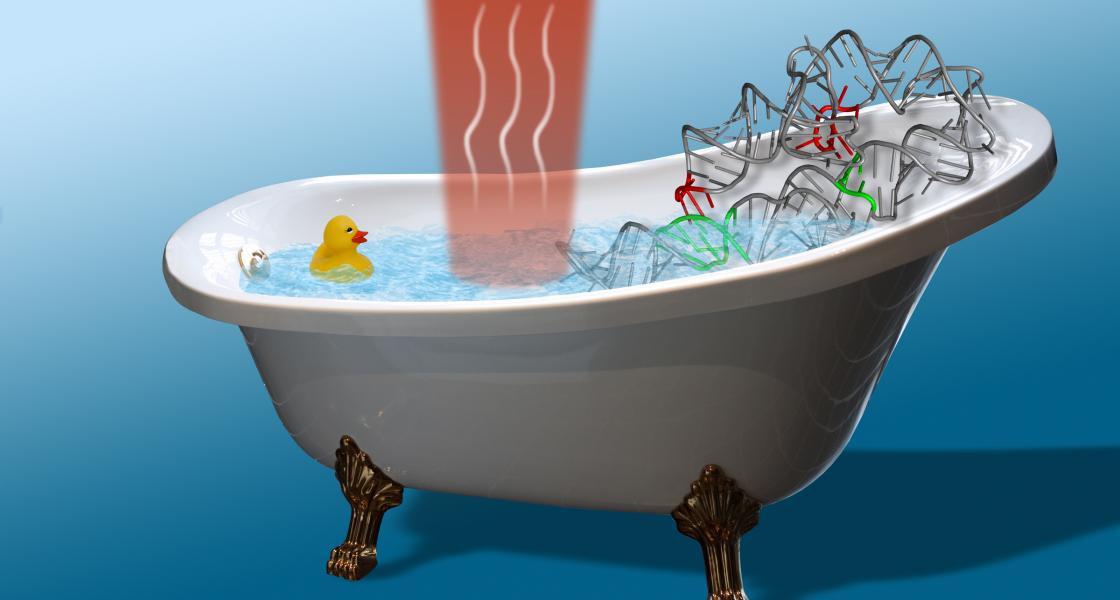In microscopic studies of single biological molecules or nanoparticles, it’s useful to be able to precisely control the temperature around the sample. Until now, heating has required electric currents that warm up microscope stages, slides, and optics in addition to the specimen under study. Such methods are slow and hard to control, not to mention capable of accidentally altering the chemistry or structure of the sample. Now there is a better solution for keeping samples nice and warm: The nanobathtub.
Graduate student Erik Holstrom and Fellow David Nesbitt have come up with a way to precisely control the temperature of tiny “bathtubs” of water on a glass slide. The column-shaped bathtubs contain only 35 trillionths of a liter of water, which is easily warmed with gently focused laser light. The heating laser is aimed at the samples from above and forms a spot size of about 20 micrometers. Its near-infrared light is the perfect wavelength for inducing the oxygen-hydrogen (OH) bonds in water to start vibrating. These vibrations are responsible for warming up the water in the nanobathtub. As the water warms, the researchers can monitor any changes in their sample with a fl uorescence microscope. Such laser-induced–fl uorescencebased microscopy techniques have been used extensively by the Nesbitt group to study single molecules of RNA.
What’s new is that if a nanobathtub containing a single molecule of RNA is attached to the slide, the laser can warm the RNA molecule to exactly any temperature between 20 to 90 ºC (68 to 194 ºF). This capability means that researchers can now perform experiments that use sudden, controlled jumps in temperature to activate specific molecular processes and observe them in real time.
Before attempting these new experiments, however, Holstrom and Nesbitt decided to compare observations of RNA folding that occurred in the nanobathtubs with folding that took place when the entire slide and microscope stage were heated with an electric current. They found that the new bathtub-heating method worked just as well as the older method for studying single RNA molecules. In the process, they showed that the new laser-based method was able to heat the bath water with an accuracy of half a degree Celsius in less than 20 milliseconds!
This level of control is possible because all temperature changes that affect the RNA sample in the nanobathtub are controlled by the laser. The microscope stage, which remains at room temperature, no longer has any effect on the temperature of the sample. - Julie Phillips



 The Physics Frontiers Centers (PFC) program supports university-based centers and institutes where the collective efforts of a larger group of individuals can enable transformational advances in the most promising research areas. The program is designed to foster major breakthroughs at the intellectual frontiers of physics by providing needed resources such as combinations of talents, skills, disciplines, and/or specialized infrastructure, not usually available to individual investigators or small groups, in an environment in which the collective efforts of the larger group can be shown to be seminal to promoting significant progress in the science and the education of students. PFCs also include creative, substantive activities aimed at enhancing education, broadening participation of traditionally underrepresented groups, and outreach to the scientific community and general public.
The Physics Frontiers Centers (PFC) program supports university-based centers and institutes where the collective efforts of a larger group of individuals can enable transformational advances in the most promising research areas. The program is designed to foster major breakthroughs at the intellectual frontiers of physics by providing needed resources such as combinations of talents, skills, disciplines, and/or specialized infrastructure, not usually available to individual investigators or small groups, in an environment in which the collective efforts of the larger group can be shown to be seminal to promoting significant progress in the science and the education of students. PFCs also include creative, substantive activities aimed at enhancing education, broadening participation of traditionally underrepresented groups, and outreach to the scientific community and general public.